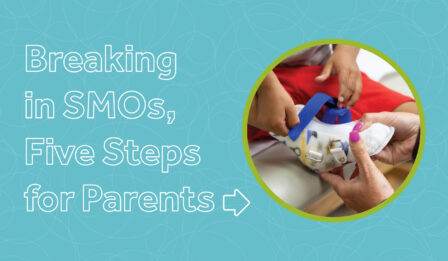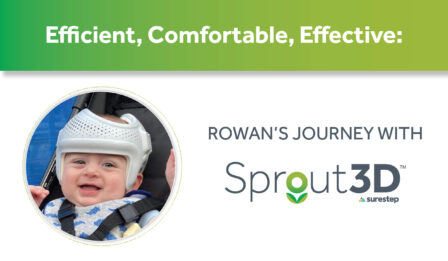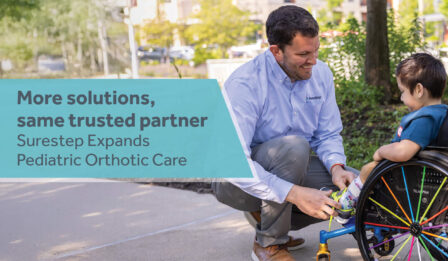Pronation In Kids – Answers To Questions You’re Asking

As a parent, it’s almost impossible not to play the comparison game.
You want to believe everything is fine. But as other kids learn to stand, walk, and run, your little one seems to be falling behind. It’s natural to wonder why. And with each passing day, those questions get louder:
- Does my child have a walking problem?
- Why do my child’s ankles roll in?
- Why is my toddler walking on the inside of her foot?
Asking these kinds of questions is the first step in the right direction. Each child is different, but one common cause for these sorts of obstacles is pronation.
What Is Pronation?
Pronation, often called flat feet, flexible flat foot, pes planus, or overpronation, refers to the inward roll of your child’s ankle.
When standing barefoot, the problem is easy to spot. The naturally occurring arch of your child’s foot is either reduced or gone altogether. And while it looks like a foot problem, it actually starts in the heel. The calcaneus (a fancy word for heel bone) rotates inward. Body weight then shifts in also, causing your child to walk and stand on the inside part of his or her foot.

What Causes Pronation In Kids?
There isn’t just one cause. But for kids who have low muscle tone, ligament laxity is a common culprit. What is that?
Well, ligaments are the flexible fibers that connect bones or joints. They make sure joints don’t move beyond the normal range of motion. But if these ligaments are overly relaxed, joints move too far. And in the case of pronation, this causes ankles to roll in.
What Problems Does It Cause?
You may see the effects of pronation even before your child starts walking. Developmental delays with pulling to stand and cruising are common.
And then there are the clumsy steps. The gait of a toddler who pronates is often sloppy or immature compared to other kids the same age. Additionally, your child may be slow to master gross motor skills such as:
· Running
· Bending over
· Jumping
· Climbing stairs
· Standing on one foot
Pronation can also leave your child exhausted. His or her muscles work harder due to the body’s poor positioning. This may be why your child is more inclined to sit rather than run and play.
Keep in mind that pronation isn’t just a foot problem. It starts a chain reaction. That inward ankle roll can cause knees, hips, and back to shift out of alignment. If left untreated, expect pain in all three areas.

What Should I Do If My Child Pronates?
First off, remember that some pronation is normal. A toddler’s body is always growing and changing. A slight ankle roll while standing or walking doesn’t mean you need to rush off to a doctor.
What you should keep an eye out for is pronation that is excessive and symptomatic. This means watch for pain, fatigue, clumsiness, and developmental delays. They’re all symptoms of a bigger issue.
For kids who fall into this category, start with a pediatrician. He or she can get you moving on to the next step, which could be physical therapy or a trip to an orthotist. If a little education or convincing is needed, you can direct your doctor to a variety of helpful resources found here on the Surestep site.
What Ankle Pronation Treatment Options Do I Have?
One highly effective treatment is the revolutionary Surestep SMO. These little ankle braces are custom-made pediatric orthotics designed to correct pronation. With uniquely flexible plastic, it provides the stability and comfort your child needs.
To understand how the SMOs work, think about training wheels. When learning to ride a bike, kids tip back and forth. They’re still pedaling and using their own muscles. Training wheels just provide that necessary stop before tipping over. With practice, kids don’t need them anymore.
It’s the same with Surestep SMOs. They provide stability and won’t let the foot/ankle slide into that excessive position. But your child’s muscles continue to do all the work. With enough repetition and muscle memory, the SMOs can be taken away without your child becoming dependent on them.

Don’t let the ordering process confuse you: GET SURESTEP
How Do Surestep SMOs Address Pronation?
This gets a little confusing but stay with us.
Pronation is triplanar. This means it happens in three planes of motion. More simply, you can think of it as affecting three parts of the foot:
· Back (the heel bone rolls in)
· Side (the arch flattens out)
· Top (the forefoot pushes out, creating a boomerang shape)
Surestep SMOs treat pronation in all three of these planes. We start at the source. By moving the heel bone back into place, the arch reappears naturally. And Surestep’s unique trim lines (as opposed to full footplates) help move the forefoot back into position.
Most other orthotic devices try to take a shortcut by simply forcing the arch back up. But this doesn’t address the root problem. It’s like taking medicine to fight symptoms rather than the sickness itself. And many kids who use this type of product still pronate. They’re just pronating on top of an orthotic.
This is one of many reasons why it’s important to ask for Surestep SMOs by name. You don’t want an inferior substitute.
Does your child need SMOs? Ask yourself these 7 questions.



